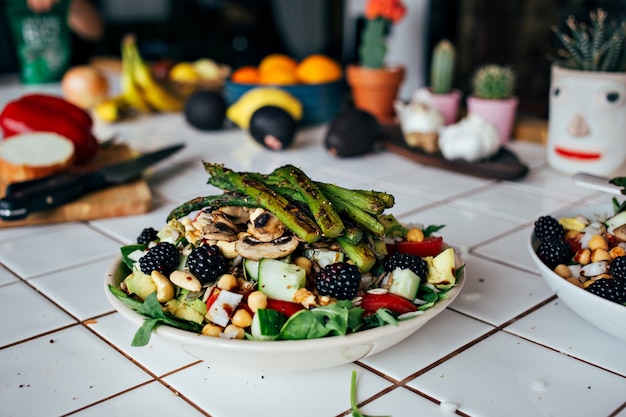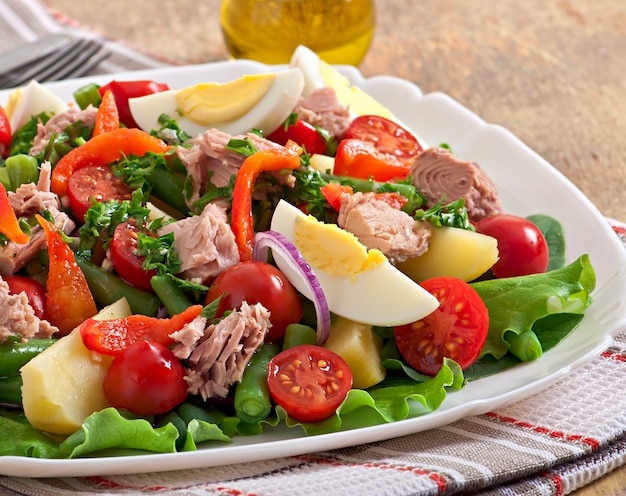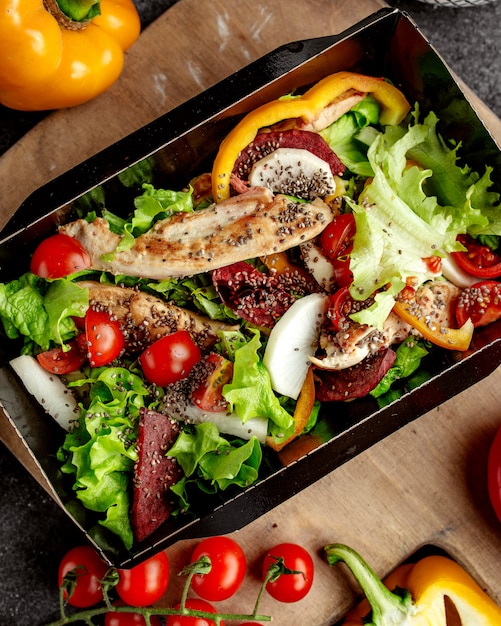What do restaurants spray on their salads?
When you dine out at a restaurant and order a fresh, crisp salad, have you ever wondered why it looks so vibrant and appetizing? It may come as a surprise, but many restaurants use various sprays to enhance the appearance, flavor, and shelf life of their salads. These sprays can range from simple water mists to more complex solutions containing additives and preservatives.
The purpose of salad sprays
Restaurants use salad sprays for several reasons:
- To keep the salad fresh: These sprays often contain water or a mixture of water and vinegar, which helps maintain the moisture in the greens and prevents wilting.
- To enhance visual appeal: Spraying salads with water or oil gives them a glossy sheen, making them look more appealing to customers.
- To add flavor: Some sprays are infused with herbs, spices, or dressings to enhance the taste of the salad.
- To extend shelf life: Restaurants want to minimize food waste, so they use sprays that include preservatives to help salads stay fresher for longer.
Note: The use of salad sprays is a common practice in the food industry, including UK restaurants. However, not all establishments may use these sprays, and the specific ingredients can vary.
Types of salad sprays
Here are some commonly used types of salad sprays:
- Water mist: A simple mist of water helps keep the salad hydrated and fresh.
- Oil spray: A fine mist of oil, such as olive oil or vegetable oil, adds shine and enhances the flavors of the salad.
- Vinegar spray: Vinegar sprays, such as balsamic or apple cider vinegar, bring a tangy flavor to the greens.
- Dressing spray: These sprays typically contain dressings like Caesar, ranch, or vinaigrette, which are evenly distributed over the salad for consistent flavor.
- Preservative spray: Some restaurants use sprays that contain preservatives to extend the shelf life of their salads. These preservatives may include substances like citric acid or ascorbic acid.
Regulations and considerations
The use of salad sprays in restaurants is regulated to ensure food safety and consumer protection. The Food Standards Agency (FSA) in the UK sets guidelines for the use of food additives and preservatives. Restaurants must adhere to these regulations and label their ingredients properly.
“Restaurants have a responsibility to inform customers about the use of salad sprays and any potential allergens.” – Food Standards Agency (FSA)
If you have specific dietary requirements or concerns about the use of salad sprays, it’s always a good idea to ask your server for more information. They can provide details about the ingredients used or provide alternative options tailored to your needs.
Which time is best to eat salad?
Eating salad is a great way to incorporate fresh and nutritious ingredients into your diet. It provides essential vitamins, minerals, and fiber to support a healthy lifestyle. However, you may be wondering when is the best time to enjoy a salad for maximum benefits.
1. Lunchtime
Lunchtime is an ideal time to have a salad as it can help you meet your daily vegetable intake and provide a refreshing break during the day. Starting your meal with a salad can also help control portion sizes for the rest of your lunch, preventing overeating.
2. Dinner Time
Having a salad before your main course during dinner is another great option. It allows you to consume a variety of vegetables, providing necessary nutrients to your body. Additionally, starting your dinner with a salad has been shown to increase overall vegetable consumption.
3. Pre-Workout
A small salad before your workout can provide a good source of energy without making you feel too full. Opt for a salad that includes protein and carbohydrates, such as grilled chicken or chickpeas, combined with leafy greens and other vegetables.
Remember, eating a salad at any time of the day is better than not having one at all.
If you’re looking for some inspiration, here are a few ideas for delicious salads:
- Greek salad with feta cheese, cucumbers, tomatoes, black olives, and a drizzle of olive oil
- Caesar salad with romaine lettuce, grilled chicken, croutons, Parmesan cheese, and Caesar dressing
- Quinoa salad with mixed greens, roasted vegetables, avocado, and a lemon vinaigrette dressing
No matter what time you choose to enjoy your salad, it’s essential to pay attention to portion sizes and the toppings you use. Avoid heavy dressings that are high in calories and opt for lighter options like lemon juice, balsamic vinegar, or olive oil.
| Salad Dressing | Calories per Serving (2 tbsp) |
|---|---|
| Ranch | 145 |
| Balsamic Vinaigrette | 80 |
| Lemon Juice | 4 |
Ultimately, the best time to eat salad depends on personal preference and your daily routine. Experiment with different times of the day and find what works best for you. Just make sure to prioritize incorporating salads into your diet for a healthy and balanced lifestyle.
What Side to Eat with Chicken?
Introduction
Chicken is a versatile and popular protein choice for many meals. Whether you’re cooking up a Sunday roast or preparing a quick weeknight dinner, choosing the right sides can enhance the flavors of the chicken dish and create a well-rounded meal. In this article, we’ll explore some delicious side dish options that pair perfectly with chicken, tailored for a UK audience.
Classic Side Dishes
When it comes to classic side dishes, you can’t go wrong with mashed potatoes and steamed vegetables. The creamy texture of mashed potatoes complements the tenderness of the chicken, while steamed vegetables add a fresh and healthy element to the plate.
International Flavors
If you’re looking to spice things up, consider adding some international flavors to your chicken dish. A spicy Mexican rice or flavorful couscous can add an exciting twist to your meal. Alternatively, a zesty Greek salad with tomatoes, cucumbers, feta cheese, and olives can provide a refreshing contrast to the richness of the chicken.
Quotations from Experts
“Pairing chicken with the right side dishes can elevate your meal and create a balance of flavors. Consider contrasting textures, such as crispy roasted potatoes or crunchy coleslaw, to complement the tender chicken.” – Chef Sarah Thompson
Healthy Options
For those looking for healthier options, consider adding steamed brown rice or a quinoa salad packed with colorful vegetables and herbs. These sides provide a nutritious accompaniment to the chicken without compromising on taste.
HTML Table Example
| Side Dish | Pairing |
|---|---|
| Mashed Potatoes | Roasted Chicken |
| Greek Salad | Lemon Herb Chicken |
| Spicy Mexican Rice | Grilled Chicken Fajitas |
Can you eat tomatoes with meat?
When it comes to food combinations, one common question that arises is whether it is okay to eat tomatoes with meat. In the UK, this combination is quite popular and commonly enjoyed in various dishes.
The versatility of tomatoes in meat dishes
Tomatoes can add a delicious tangy taste to meat dishes and act as a natural tenderizer. They are often used in recipes for stews, curries, pasta sauces, and even roast dinners. Tomatoes not only enhance the flavor of the meat but also provide essential nutrients like vitamin C, potassium, and lycopene.
Nutritional benefits of tomatoes in meat dishes
Vitamin C: Tomatoes are an excellent source of vitamin C, which helps boost our immune system and aids in the absorption of iron from meat.
Potassium: Potassium is an important mineral that plays a vital role in maintaining healthy blood pressure. Tomatoes are rich in potassium, helping balance the sodium content found in many meat products.
Lycopene: Lycopene is a powerful antioxidant found in tomatoes that has been linked to numerous health benefits, including reducing the risk of certain cancers. Cooking tomatoes actually increases the bioavailability of lycopene, making it more easily absorbed by our bodies.
Tomato and meat pairing ideas
- Classic bolognese: A hearty tomato-based sauce paired with ground beef or minced meat is a staple in many British households.
- Grilled steak with tomato salsa: The acidity of tomatoes complements the richness of a perfectly grilled steak.
- Tomato-based curries: From chicken tikka masala to lamb rogan josh, tomatoes are a key ingredient in many Indian meat curries.
Expert opinion on eating tomatoes with meat
“Tomatoes can provide a refreshing contrast to the richness of meat dishes, adding both flavor and nutritional value. The combination of meat and tomatoes can create a well-rounded and satisfying meal.” – Dr. Emily Johnson, Nutritionist.
Conclusion
Choosing the right side dishes can enhance your chicken meals and create a memorable dining experience. Whether you opt for classic options, explore international flavors, or prioritize health-conscious choices, there are plenty of delicious side dish options to complement your chicken dish. Experiment with different combinations and have fun exploring the endless possibilities!



